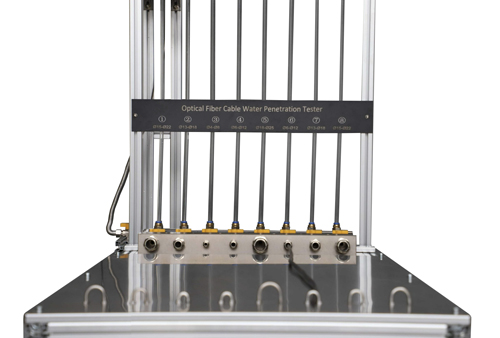25 Method F5: Water penetration
25.1 Object
This test applies to continuously water-blocked cables. The purpose is to determine the ability of a cable to block water migration along a specified length.
Compliance shall be checked on samples of cable using one of the two following methods (F5A or F5B), as stated in the detail specification. Method F5A tests for water migration between the outer interstices of the optical core and the outer sheath, whereas method F5B tests for water migration over the entire cross-section designed to be water-blocked.
25.2 Sample
25.2.1 Method F5A
A circumferential portion of sheath and wrapping 25 mm wide shall be removed 3 m from one end of a sample length of cable and a watertight sleeve shall be applied over the exposed core so as to bridge the gap in the sheath and allow a 1 m height of water to be applied.
25.2.2 Method F5B
A cable sample 1 m longer than the length to be tested, which shall not exceed 3 m is used. If required, the sample is submitted to the bending procedure according to 14.4.2. A maximum cable length of 3 m shall then be taken from the central portion of the sample. A watertight sealshall be applied to one end of the sample to allow a 1 m height of water to be applied.
NOTE For armoured cables where the armour is not designed to be water-blocked, the armour may be removed before the application of the seal.
25.3 Apparatus
Suitable test arrangements are shown in Figure 31.
25.4 Procedure
Unless otherwise specified in the detail specification, the sample shall be supported horizontally and a 1 m height of water shall be applied for 24 h, at a temperature of (20 ± 5) °C. A water soluble fluorescent dye or other suitable colouring agent may be used to aid in the detection of water seepage. Care should be taken in choosing a fluorescent dye that does not react with any of the cable components.
25.5 Requirements
No water shall be detected at the unsealed end of the sample. If a fluorescent dye is used, an ultraviolet light may be used for the examination.
NOTE The test procedure mentioned above is a basic compliance requirement and for routine tests; samples of shorter length may be tested for a shorter time.
25.6 Details to be specified
The detailed specification shall include the following:
a) method used and cross-section tested;
b) bending procedure applied, where applicable;
c) quantity and type of dye, where applicable.


Water Penetration Tester According to IEC 60794-1-2 F5B
- According to F5B
- Minimum outlet diameter 5.4 mm
- Maximum outlet diameter 20.6 mm
- Number of outlets 8
- Wager height 1 m
- Sample length 1 m
